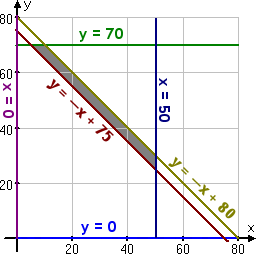A Word Problem with Four Variables .
Sections: Optimizing linear systems, Setting up word problems
INTRODUCTION:
- A building supply has two locations in town. The office receives orders from two customers, each requiring 3/4-inch plywood. Customer A needs fifty sheets and Customer B needs seventy sheets. The warehouse on the east side of town has eighty sheets in stock; the west-side warehouse has forty-five sheets in stock. Delivery costs per sheet are as follows: $0.50 from the eastern warehouse to Customer A, $0.60 from the eastern warehouse to Customer B, $0.40 from the western warehouse to Customer A, and $0.55 from the western warehouse to Customer B.
Find the shipping arrangement which minimizes costs.
Hmm... I've got four things to consider:
- east warehouse to Customer A
east warehouse to Customer B
west warehouse to Customer A
west warehouse to Customer B
The variables obviously need to stand for the number of sheets being shipped, but I have four different sets of sheets. This calls for subscripts and explicit labelling:
- shipped from east warehouse to Customer
A: Ae
shipped from west warehouse to Customer A: Aw
shipped from east warehouse to Customer B: Be
shipped from west warehouse to Customer B: Bw
- Ae + Aw
= 50, so Aw
= 50 – Ae (I'll
call this Equation
I)
Be + Bw = 70, so Bw = 70 – Be (I'll call this Equation II)
- 0 < Ae
+ Be < 80
0 < Aw + Bw < 45
- C = 0.5Ae
+ 0.6Be + 0.4Aw + 0.55Bw
- 0 < Ae
+ Be < 80
0 < (50 – Ae) + (70 – Be) < 45
|
|
|
|
|
|
- 0 < Ae
+ Be < 80
0 < 120 – Ae – Be < 45
- 0 < Ae
+ Be < 80
120 > Ae + Be > 75
- 75 < Ae
+ Be < 80
- C = 0.5Ae
+ 0.6Be + 0.4Aw + 0.55Bw
= 0.5Ae + 0.6Be + 0.4(50 – Ae) + 0.55(70 – Be)
= 0.1Ae + 0.05Be + 58.50
- 0 < Ae
< 50
0 < Be < 70
- x = Ae
y = Be
|
Minimize C
= 0.1x + 0.05y + 58.50,
subject to the following: |
|
y > 0 y > –x + 75 |
y < 70 y < –x + 80 |

5 sheets from the eastern warehouse to Customer A70 sheets from the eastern warehouse to Customer B45 sheets from the western warehouse to Customer A
0 sheets from the western warehouse to Customer B
No comments:
Post a Comment